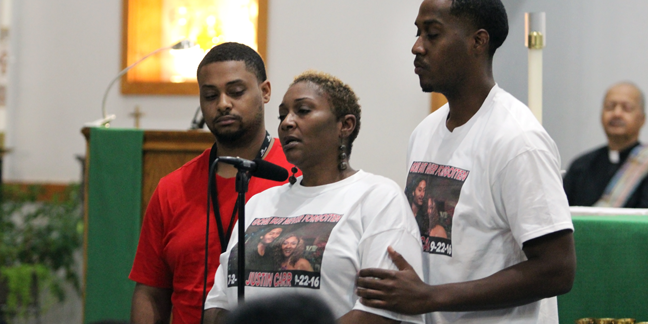 CHARLOTTE — Justin Carr's future looked bright. He had just celebrated his 26th birthday, started a new job, and was getting ready to settle down with his high school sweetheart and start a family.
CHARLOTTE — Justin Carr's future looked bright. He had just celebrated his 26th birthday, started a new job, and was getting ready to settle down with his high school sweetheart and start a family.
But all that ended the night of Sept. 21, when a bullet shattered his skull. The next day, he was dead.
Carr's death marked the most violent episode in nearly a week of protests in Charlotte that erupted after another man, Keith Lamont Scott, was shot and killed by police Sept. 20 in an apartment complex parking lot.
Demanding justice in the police shooting, protesters marched through uptown Charlotte Wednesday evening and confronted police in riot gear. Carr was among them.
"I need to make a stand," he told his mother when he called her from the scene. He said he wanted to follow in the footsteps of his grandmother, who had marched during the civil rights era.
Less than an hour later, Vivian Carr learned her son was in the hospital, clinging to life.
Charlotte-Mecklenburg police have charged Rayquan Borum, 21, in Carr's death.
Pictured at top: The family of Justin Carr speaks out about his death during a prayer service Sept. 23 at Our Lady of Consolation Church in Charlotte. From left are Ellis Carr, brother; mother Vivian Carr; and brother Kenneth Johnston.
Vivian Carr recounted her last memories of her son during a special prayer service Sept. 23 at Our Lady of Consolation Church, where the Carr family has worshipped for three generations.
The prayer service was organized by Father Carl Del Giudice, pastor, to give people a chance to share their feelings about the protests and the tragedy that had struck their parish family. Father Del Giudice gave Carr last rites before he died, and is ministering to the Carr family throughout the tragedy.
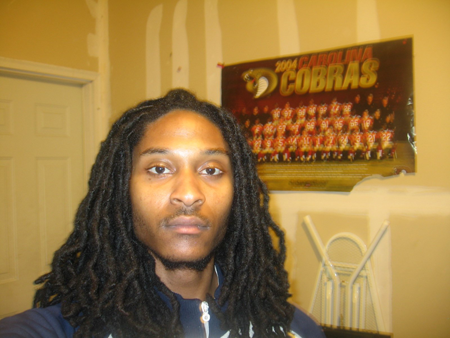 Justin Carr (Photo courtesy of Facebook)"I know that my son died for a cause," Vivian Carr told a standing-room-only crowd gathered in the church on Statesville Avenue.
Justin Carr (Photo courtesy of Facebook)"I know that my son died for a cause," Vivian Carr told a standing-room-only crowd gathered in the church on Statesville Avenue.
"I just want to thank everybody for coming out and thanks for all of the love and support that everybody's given," she continued. "It's very, very, very hard for me. This is the hardest thing I've ever had to do in my life. But through everybody's love, support and my strength in God, I'm able to carry through this."
Carr's two brothers praised him for standing up for people's rights and they defended his reputation from what they called false social media reports.
Struggling to find words through his tears, Ellis Carr said, "They took my best friend. He was the best big brother ever."
During the prayer service, people spoke of their fear of getting stopped by police or their sons getting racially profiled.
"I am scared," said one woman who has one son and four grandchildren. "I'm asking all of you to hug your sons, keep them close, make sure that they are extra (careful) when they leave home, because we don't know."
Others begged people to get involved in the community, uniting to turn their anger into economic and political change.
With black Americans' spending power, one speaker said, "our dollars can talk. If they don't understand anything else, they don't understand our marching, they don't understand our protesting, I promise you they'll understand dollars."
Father Del Giudice acknowledged people's anger and fear, but he encouraged them to lift each other up and bring their Catholic faith into the world, "uplifting and elevating others to do better, and honoring and recognizing who we are."
Deacon Curtiss Todd similarly challenged people to "think and talk and act just like Jesus."
He recounted his own experiences with racism while growing up in segregated Winston-Salem, including one incident at the local country club pool, which at one time was for white people only. He recounted how a little boy was allowed to bring his dog into the pool, but when a black employee accidentally fell into the pool that same day, "they immediately closed the pool, drained it, scrubbed it, disinfected it, before they would let people back in to it. What’s the lesson I learned? That many whites see blacks as less than animals."
Hatred, though, comes from the devil, who seeks to divide us, Deacon Todd said. Instead, people should look to Jesus as their example.
"Develop a personal relationship with Jesus," he said. "Rely on God."
"When we develop that personal relationship with Jesus, we begin to think, talk and act just like Him. We have that relationship where we know what He would do in a certain situation," he said. "It doesn't mean turn the other cheek, let somebody walk all over you. It means, yes, you can protest but you have to protest within the range that God gives you."
Vivian Carr echoed his advice. "I stand here today to say, especially to the young people: if you're going out, go in peace. Don't go down there acting crazy."
"I know you're angry. Of course, I'm angry, too," she said. "But I have God with me."
Carr's pregnant girlfriend Tanae Ray was the last person to speak at the prayer service. In her emotional remarks, Ray described how they had been close friends for years before they began dating in the ninth grade. Their relationship had been "on and off" over the years, but recently he had asked to marry her.
Over the past few weeks, she said, "he was just so excited, the happiest I've ever seen him."
When Carr told her Wednesday that he was going to the protest, she didn't think he was serious. She said she regretted not stopping him from going. "I feel like I could have prevented it."
"If I had known these were his last days I would have cherished it," she continued through her tears.
"Now I'm carrying his son. Everybody's saying, 'It's going to be OK.' But it's not. I need Justin. Ain't nobody can take his place – no brothers, uncles, cousins. I need him, and I don't have him," she wept. "How do I live without my best friend? How do I stay strong? He was everything to me.
"They say time heals all wounds. I just hope that's the case with me. But I just don't feel I can make it without him."
After his death, Carr's heart, lungs and liver were donated to enable other people to live, Vivian Carr said.
"His heart beats on," she said. "He's already helped save three other lives."
— Patricia L. Guilfoyle, editor
How you can help
- A GoFundMe account, “Justice for Justin,” has been created to help the Carr family with unexpected expenses.
- Cards and well-wishes may also be sent to Our Lady of Consolation Catholic Church, 1235 Badger Ct., Charlotte, NC 28206.
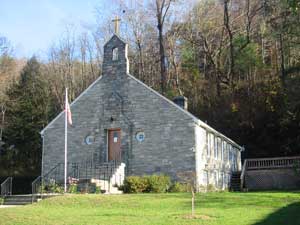 ‘This parish is meant for community’
‘This parish is meant for community’
BRYSON CITY — Sept. 18 was a special day for the mountain parish community of St. Joseph and its mission in Cherokee. The day was a celebration of the 75th anniversary of St. Joseph’s Church dedication, as well as the 50th anniversary for Our Lady of Guadalupe Mission’s dedication. Bishop Peter Jugis was on hand to offer the anniversary Mass, as well as to administer the sacrament of confirmation to two Bryson City youths, Tayla Holt and James Posey.
In his homily, Bishop Jugis encouraged the two youths, and all of the parishioners, to grow in holiness.
“The Church is here for our sanctification, for our salvation,” he said. “We cannot do it by ourselves. We need the help of others to grow in holiness and to stay on the path to our salvation.”
He emphasized that the Church is here to strengthen the faithful so that they can go out into the world and spread the Gospel.
“Don’t let it stop here, go out into the world,” he said. “Everywhere you go, you represent Christ. We are His missionaries; we have to do our part. This is what binds us together as a parish family.”
The anniversary Mass was a close-knit affair in the small Smoky Mountain church that sits along the Tuckasegee River, which flows right through the town of 1,300 people.
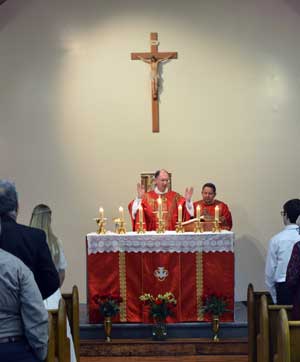
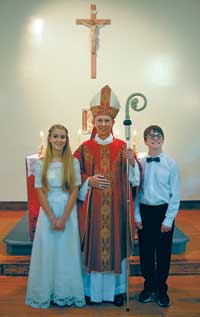 Parishioner Dave Baker, a cantor and one of the five choir members, said, “There is warmth here, a sense of authenticity within this small collection of families. It is truly delightful, and maybe the combination of family and small mountain town makes it feel so genuine.”
Parishioner Dave Baker, a cantor and one of the five choir members, said, “There is warmth here, a sense of authenticity within this small collection of families. It is truly delightful, and maybe the combination of family and small mountain town makes it feel so genuine.”
“The 75th anniversary of the dedication of St. Joseph’s and the 50th anniversary of the dedication of Our Lady of Guadalupe Mission are reminders that the faith is something that must be handed on by one generation and received by the following one,” said Father Peter Shaw, pastor.
“It humbles me to be part of the work of so many priests, deacons, sisters and laity who have labored and nourished the faith in these mountains. God willing, our community here in Bryson City and the Qualla boundary will continue to give witness to the truth for many more years, to play our part in the unbroken handing on of the faith that was given from Christ through His Apostles and the bishops, to each of us.”
Before Easter, the church installed a new tabernacle behind the altar. The 100-year-old tabernacle was purchased by Father Shaw and restored in time for the anniversary celebration, thanks to the generosity of anonymous benefactors. The new tabernacle caps a year of improvements at the church, including a new Allen organ, altar candles and crucifix, altar linens and sanctuary lamp.
“Another impressive point from today, for me, was seeing Father Shaw move the tabernacle behind the altar,” Baker said. “It’s truly glorious having a central place of honor for Our Lord.”
Confirmation candidate Tayla Holt honored her grandmother, who has been married for 50 years, by wearing her wedding dress as her confirmation dress.
Said Holt’s mother Kim Holt, “I have been with St. Joseph Parish since I moved down to North Carolina 25 years ago. Over the years it has become part of my family and it has been a wonderful blessing to have my own marriage and all my children’s sacraments here. It is a beautiful church in the heart of the Smokies.”
Lectors at the Mass were Joe Kamarata, parish council chairman, and Kathy Posey, the parish’s faith formation coordinator and mother of confirmation candidate James Posey. Joe and Lisa Kamarata brought up the offertory gifts. Dr. David Ramsey III, a parishioner of St. Mary, Mother of God Church in Sylva and a candidate in the diaconate formation program, served at the Mass.
Craig Car, the parish picnic coordinator, and several volunteers helped to make the parish picnic that followed the Mass a great success. Along with a variety of foods and desserts, there was a silent auction and raffle for the parish’s Respect Life Committee. Families and friends enjoyed the day and being together as a parish.
Bob Burns, a parishioner for 22 years, said, “This parish is meant for community. It was a great success and I believe there were over 100 people here. This was a very good turnout.”
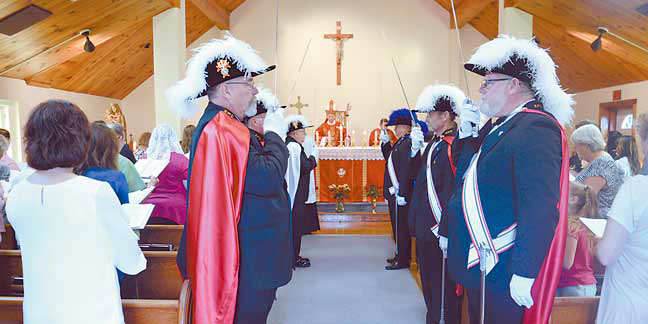 “I couldn’t have been happier or more proud as a pastor and spiritual father,” said Father Shaw. “There was much work that was done quietly and behind-the-scenes, so to speak, to make the day as wonderful as it was. Between the planning and working of the picnic, the hours of practicing by the choir, and the mundane (but important) work of cleaning the church, I couldn’t have done it myself. So thank you to everyone that helped to make the day so pleasantly memorable. As a parish, we have many reasons to be proud and grateful.”
“I couldn’t have been happier or more proud as a pastor and spiritual father,” said Father Shaw. “There was much work that was done quietly and behind-the-scenes, so to speak, to make the day as wonderful as it was. Between the planning and working of the picnic, the hours of practicing by the choir, and the mundane (but important) work of cleaning the church, I couldn’t have done it myself. So thank you to everyone that helped to make the day so pleasantly memorable. As a parish, we have many reasons to be proud and grateful.”
— Della Sue Bryson, Correspondent
Our Lady of Guadalupe unique church in N.C. mountains
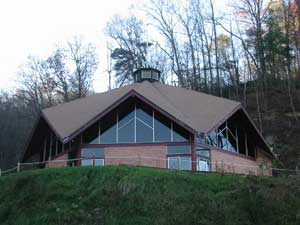 CHEROKEE — The Catholic Church in Cherokee is the product of combining Roman Catholic tradition with Native American heritage – an amalgamation of cultures set in the western North Carolina mountains.
CHEROKEE — The Catholic Church in Cherokee is the product of combining Roman Catholic tradition with Native American heritage – an amalgamation of cultures set in the western North Carolina mountains.
Catholics living in and around Cherokee gathered for liturgies in various places prior to the church’s construction in the mid-1960s. Glenmary priests serving the westernmost sections of North Carolina ministered to Cherokee Catholics.
Lelia Queen, a convert to Catholicism, dedicated land on which to build a new church, and plans were set for construction. Because the donated land rested in Cherokee territory, a proposal had to be sent to the Cherokee tribal council before construction could proceed.
A resolution was signed in 1960 by the principal chief, thus allowing a Catholic chapel to be built.
North Carolina Bishop Vincent S. Waters dedicated the newly built structure in August 1966, placing it under the patronage of Our Lady of Guadalupe. The building was the first Catholic church to be constructed on the Cherokee Indian Reservation.
It was said that Bishop Waters decided that the church’s design reflect Cherokee culture. Built in the pattern of the ancient and sacred Cherokee council house, the church has seven sides, representing the tribal clans.
Mosaic symbols were laid in the floor of the church, each representing a clan: the Paint, the Deer, the Panther, the Wolf, the Bird, the Potato and the Blue Holly.
Highlighting the north section of the church is a large stained glass window consisting of 5,000 glass pieces and representing Catholic and Native American traditions and history. In 1963, Bishop Waters commissioned Dutch artist Franz Van Bergen to design the window.
The project took two-and-a-half years to complete. The central motif of the window is the heavenly appearance in December 1531 of the Blessed Virgin Mary to St. Juan Diego, the Aztec peasant boy who witnessed visions of Mary on a hill known as Tepeyac.
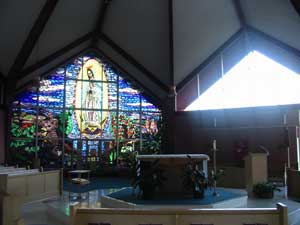 However, in an example of artistic liberty, Sequoyah, the Cherokee who designed a new alphabet that led to his people’s literacy, was placed within the window rather than St. Juan Diego. Also placed within the window are images of the traditional seven-sided council houses and the first Basilica of Our Lady of Guadalupe in Mexico City.
However, in an example of artistic liberty, Sequoyah, the Cherokee who designed a new alphabet that led to his people’s literacy, was placed within the window rather than St. Juan Diego. Also placed within the window are images of the traditional seven-sided council houses and the first Basilica of Our Lady of Guadalupe in Mexico City.
When Bishop Michael J. Begley of the newly established Diocese of Charlotte established St. Joseph Church in Bryson City in September 1972, Our Lady of Guadalupe Mission became a mission of the new parish. The Glenmary priests assigned to serve as pastors at St. Joseph – Fathers Donald Levernier, Frank Gardner and Tom Field – served the church for 25 years.
In 1997, Bishop William G. Curlin transferred ministerial care of the mission to St. Margaret of Scotland Church in Maggie Valley. Care for the mission church was restored to St. Joseph Church in July 2000 upon the arrival of Father Ray Williams as administrator, who served at the church until 2002. The current pastor is Father Peter Shaw.
— Catholic News Herald archives
St. Joseph Church embodies spirit of worship and good works in mountain community
BRYSON CITY — St. Joseph Church is located in Swain County, at the foot of the Great Smoky Mountains in western North Carolina.
In the 1930s, before the parish was established, a priest 34 miles from Waynesville would travel to Bryson City to celebrate Mass in various homes and at the Fryemont Inn.
As the Catholic community grew, a need for a Catholic church in the area became evident. Land was purchased at the east end of Bryson City’s Main Street and construction of St. Joseph Church began.
The church, built at a cost of $11,568, was dedicated by then-Bishop Eugene McGuiness of Raleigh in September 1941 and was a mission of St. John the Evangelist Church in Waynesville.
At that time, St. Joseph Church was the only Catholic church west of Waynesville and is the oldest church in that area of North Carolina.
The church building was constructed with stone from Swain County and wood native to the area was used whenever possible. At the time of the dedication, there were 20 members at St. Joseph Church.
In 1955, Glenmary priests took responsibility for the parish. A nearby training center for Glenmary priests provided an ideal situation for both parishioners and priests. While the priests were able to get hands-on experience dealing with parish life, St. Joseph Church was able to maintain a generous supply of enthusiastic priests.
In the late 1960s, St. Joseph Church was transferred from being a mission of St. John the Evangelist Church in Waynesville to a mission of St. Francis of Assisi Church in Franklin.
On Sept. 8, 1972, St. Joseph Church became an independent parish. Today, the church has its own mission, Our Lady of Guadalupe in Cherokee.
Three Glenmary priests served as pastors of St. Joseph Church after its establishment as a parish in 1972: Fathers Donald Levernier, Frank Gardner and Tom Field.
When Father Field retired in 2002, the Glenmary presence at St. Joseph Church ended.
Father Frank Seabo, a diocesan priest, served as administrator between July 2002 and July 2003. In 2003, Father Shawn O’Neal became the administrator. The current pastor is Father Peter Shaw.
The parish is involved with SAFE, a center for victims of domestic violence; Habitat for Humanity; Meals on Wheels and it actively collects food for the Bryson City Food Pantry.
In 1983, the church purchased property and began a thrift shop. Now the small shop has grown into one the largest ecumenical charities in the area. In fact, parishioners of St. Joseph Church and other area churches have kept the shop so stocked with donated goods that there has never been a need to go outside the area for donations.
— Catholic News Herald archives










